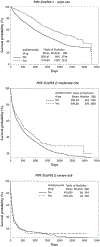Association of Antidementia Drugs and Mortality in Community-Dwelling Frail Older Patients With Dementia: The Role of Mortality Risk Assessment
- PMID: 29031515
- PMCID: PMC6125780
- DOI: 10.1016/j.jamda.2017.08.017
Association of Antidementia Drugs and Mortality in Community-Dwelling Frail Older Patients With Dementia: The Role of Mortality Risk Assessment
Abstract
Objective: To evaluate whether treatment with antidementia drugs is associated with reduced mortality in older patients with different mortality risk at baseline.
Design: Retrospective.
Setting: Community-dwelling.
Participants: A total of 6818 older people who underwent a Standardized Multidimensional Assessment Schedule for Adults and Aged Persons (SVaMA) evaluation to determine accessibility to homecare services or nursing home admission from 2005 to 2013 in the Padova Health District, Italy were included.
Measurements: Mortality risk at baseline was calculated by the Multidimensional Prognostic Index (MPI), based on information collected with the SVaMA. Participants were categorized to have mild (MPI-SVaMA-1), moderate (MPI-SVaMA-2), and high (MPI-SVaMA-3) mortality risk. Propensity score-adjusted hazard ratios (HR) of 2-year mortality were calculated according to antidementia drug treatment.
Results: Patients treated with antidementia drugs had a significant lower risk of death than untreated patients (HR 0.82; 95% confidence interval [CI] 0.73-0.92 and 0.56; 95% CI 0.49-0.65 for patients treated less than 2 years and more than 2 years treatment, respectively). After dividing patients according to their MPI-SVaMA grade, antidementia treatment was significantly associated with reduced mortality in the MPI-SVaMA-1 mild (HR 0.71; 95% CI 0.54-0.92) and MPI-SVaMA-2 moderate risk (HR 0.61; 95% CI 0.40-0.91, matched sample), but not in the MPI-SVaMA-3 high risk of death.
Conclusions: This large community-dwelling patient study suggests that antidementia drugs might contribute to increased survival in older adults with dementia with lower mortality risk.
Keywords: Dementia; antidementia drugs; comprehensive geriatric assessment; frailty; mortality; multidimensional prognostic index (MPI).
Copyright © 2017 AMDA – The Society for Post-Acute and Long-Term Care Medicine. Published by Elsevier Inc. All rights reserved.
Conflict of interest statement
The authors declare no conflicts of interest.
Figures
References
-
- Association Association. 2016. Alzheimer’s disease facts and figures. Alzheimer Dementia 2016;12:459–509. - PubMed
-
- Gambassi G, Lapane KL, Landi F, et al. Gender differences in the relation between comorbidity and mortality of patients with Alzheimer’s disease. Systematic Assessment of Geriatric drug use via Epidemiology (SAGE) Study Group. Neurology 1999;53:508–516. - PubMed
-
- Ueki A, Shinjo H, Shimode H, et al. Factors associated with mortality in patients with early-onset Alzheimer’s disease: A five-year longitudinal study. Int J Geriatr Psychiatry 2001;16:810–815. - PubMed
-
- Moritz DJ, Fox PJ, Luscombe FA, Kraemer HC. Neurological and psychiatric predictors of mortality in patients with Alzheimer disease in California. Arch Neurol 1997;54:878–885. - PubMed
Publication types
MeSH terms
Grants and funding
LinkOut - more resources
Full Text Sources
Other Literature Sources
Medical



